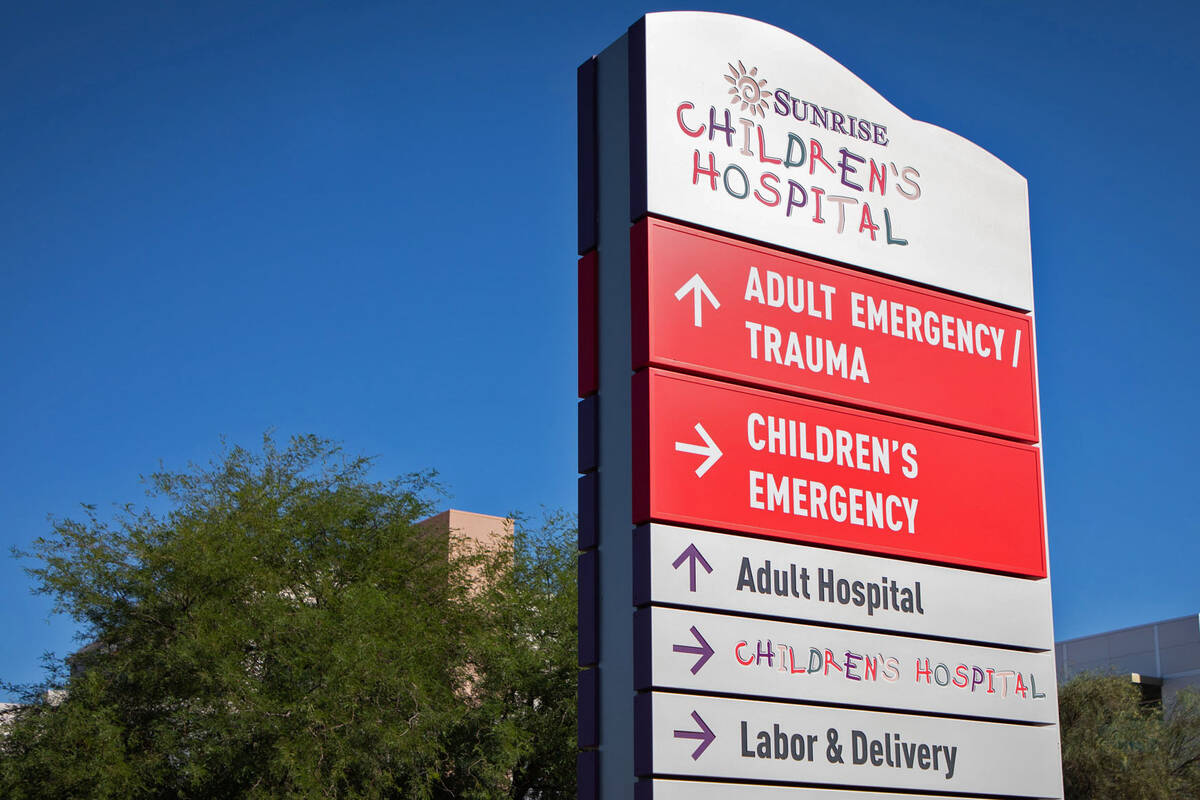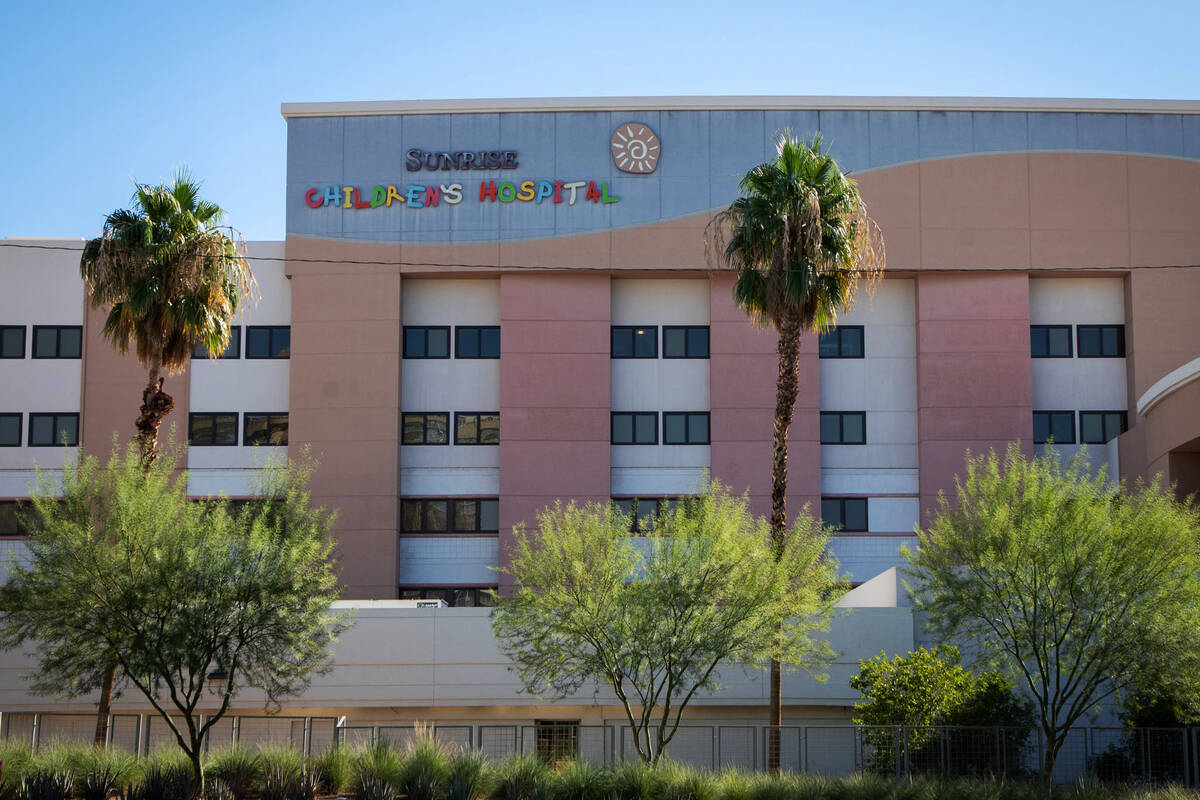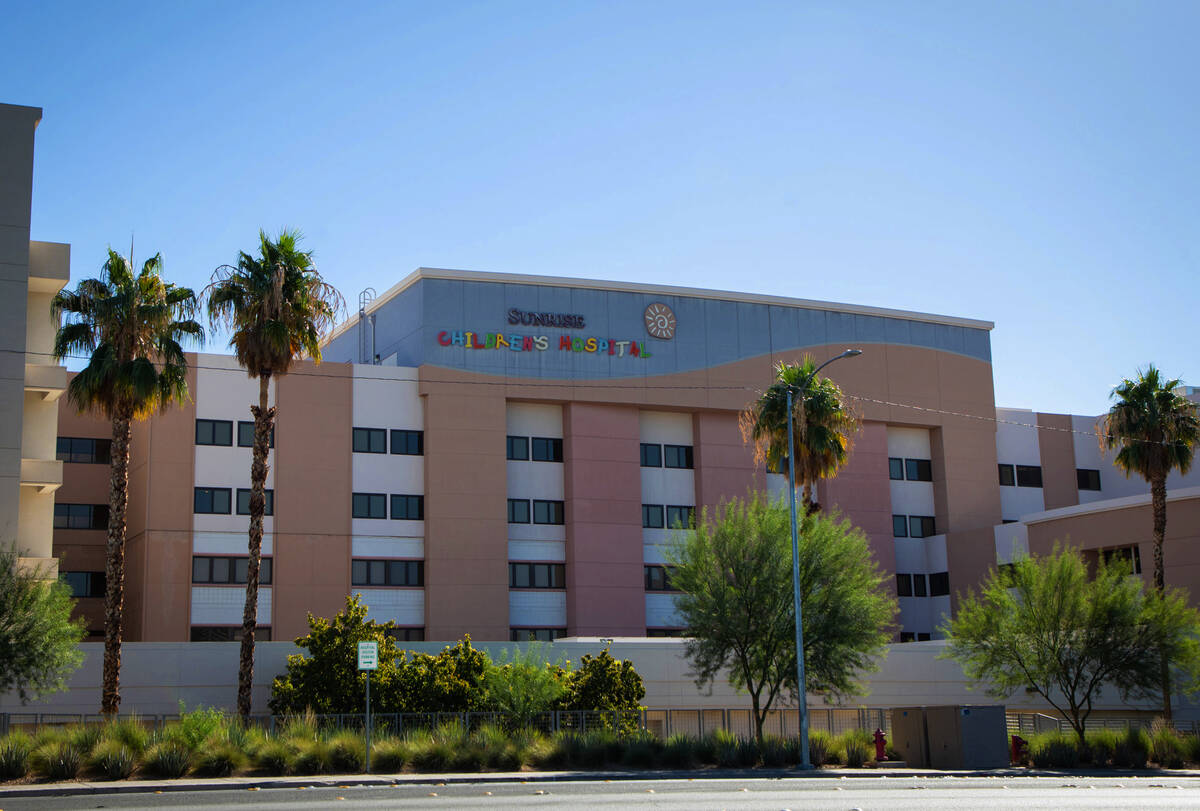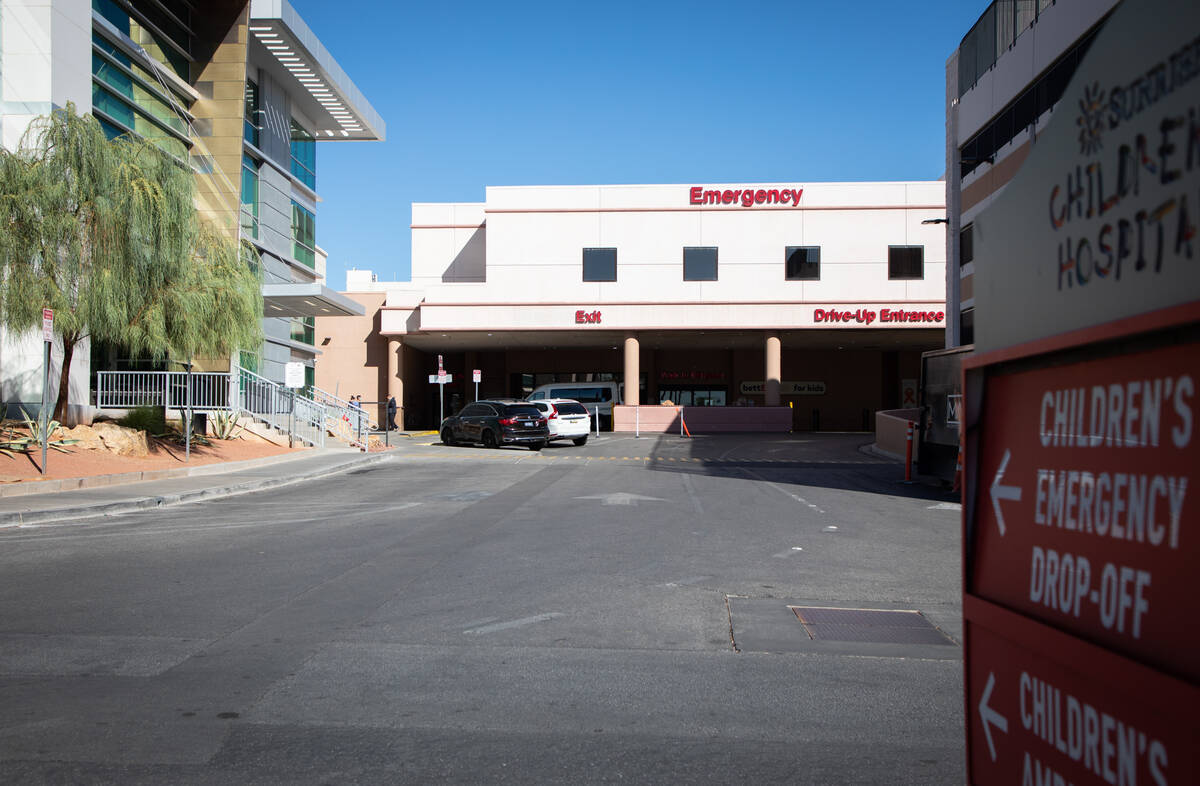First ‘superbug’ case cluster in kids identified at Las Vegas hospital
The first U.S. cluster of pediatric cases of a potentially lethal fungus was identified at a Las Vegas hospital in May as outbreaks swept across Southern Nevada medical facilities, according to records obtained by the Review-Journal.
Three cases of once-rare Candida auris, a drug-resistant “superbug,” were reported in infants with heart defects at Sunrise Hospital and Medical Center, according to a Centers for Disease Control and Prevention report obtained through a public records request.
“In the United States, less than 10 cases of C. auris have been reported in children and no clusters with multiple pediatric cases at a single facility have previously been identified,” said the report based on a consultation and site inspection in May.
A fourth pediatric case had since been identified at the hospital in a pediatric patient, according to the Nevada Department of Health and Human Services.
At highest risk for C. auris infections are patients with lengthy hospitalizations, with a central venous catheter — also known as a central line — or other lines or tubes entering their body, or who have previously received antibiotics or antifungal medications, according to the CDC.
Since August 2021 through Sept. 26 of this year, at least 536 cases have been reported at 26 hospitals and skilled nursing facilities in Southern Nevada. No cases had been detected in Nevada before last year.
Ninety-four of the cases were reported at Sunrise, the largest acute-care hospital in the region, which has pediatric intensive care units, including a cardiac unit.
Forty-two infected patients across the facilities have died, but the state has made no determination as to whether C. auris was the primary cause of death, said Kimisha Causey with the Nevada State Healthcare Associated Infection Program, part of the state health department.
Without more medical information on each patient, “You can’t really say if C. auris was the cause or if it was the underlying condition that they had,” Causey said.
One of the four children identified with C. auris at Sunrise hospital died, said Dawn Cribb, a public information officer for the state health department. Eighteen of the 42 local deaths associated with C. auris were reported at Sunrise.
‘There was no lapse’
C. auris colonizes in some patients, dwelling in folds of skin, invisible to the eye and causing no symptoms. In other patients, especially the medically frail, it can result in clinical, symptomatic cases. More than 1 in 3 patients die who have an invasive infection, such as one affecting the blood, heart or brain, according to the CDC.
Depending on the strain, C. auris is often resistant to treatment with antifungal drugs. It can’t be detected using conventional laboratory methods, which means that diagnosis and treatment can be delayed, worsening outcomes.
The fungus can spread from person to person, including by those who are colonized with it. More than 60 percent of Southern Nevada’s reported cases are colonizations.
Also vexing is that C. auris can survive for long periods of time on surfaces. It can spread through a facility on a benign piece of equipment like a laundry cart. The proper use of personal protection equipment, including gloves and gowns, and of other infection-control procedures, from basic hand-washing to high-tech cleaning protocols, can curb its spread.
To review infection-control policies at Southern Nevada facilities first reporting cases, the CDC deployed a team in May to work with the state health department.
In its report, the CDC stated there were 10 clinical cases reported in April at Sunrise, noting it is rare for an acute care hospital to report more than five clinical cases in a month, even in regions where the fungus is endemic, or regularly found.
Many of the Sunrise patients had typical risk factors for C. auris at the time of diagnosis, including mechanical ventilation (44 percent), a tracheostomy (19 percent) and a central line (61 percent).
The CDC said it reviewed which staff and equipment are shared between the pediatric and adult units of the hospital, including ultrasound, x-ray and transthoracic echocardiogram (TTE) machines. Sixty-nine percent of patients found to have the fungus had had a transthoracic echocardiogram before their diagnosis, including the three infants.
Since then, the hospital has augmented its disinfection practices for shared equipment, based on guidance from the CDC and outside experts, said Dr. Steven Merta, the hospital’s chief medical officer. But he rejected any suggestion of a lapse in disinfection practices.
“There was no lapse,” he said. “Infection prevention is a continuous improvement as we learn about new organisms that are now resistant to new drugs.”
Although some infected patients may have undergone the same procedures, he maintained that neither the procedures or the equipment caused the infections. With it endemic in the community, he suggested that patients acquired C. auris before entering the hospital.
In its report, the CDC said that patients with C. auris typically have histories of prolonged admission at long-term care and skilled-nursing facilities. But it notes that among the cases at Sunrise, more than half were admitted directly from home.
Two of the three infants were born at the hospital and had not left since birth.
The CDC concludes, “The high percentage of patients admitted from home, the long lengths of stay before C.auris identification, and the cluster of pediatric cases with limited other healthcare exposures suggest that some internal transmission is occurring.”
Sunrise now tests select patients entering the facility for C. auris, including those with wounds and certain infections, Merta said. Patients identified as having C. auris are isolated from other patients.
In consultation with the CDC and independent experts, Sunrise has augmented its infection control practices, he said. To disinfect the rooms of C. auris patients, it has added the use of electrostatic spraying, which coats surfaces, including in hard-to-reach places, with an extra layer of disinfectant.
Merta said the hospital takes the safety of community members seriously. “We do everything in our power to keep them safe and protected from a hostile pathogen environment that our community is under,” he said.
‘Game of whack-a-mole’
A genetic analysis of cases identified in Southern Nevada shows that at least three separate events introduced the fungus into the community.
The analysis showed three separate clades, or strains, of the fungus, one of which quickly died off, said Mark Pandori, director of the Nevada State Public Health Laboratory. The other two clades, of South African and African origin, spread among area medical facilities.
“If you didn’t use genetics, you would think it was just one big outbreak. But it was two facilities that got hit, and then (C. auris) spread out of those locations, is what it looks like,” said Pandori, who would not name the facilities.
The fungus can spread as patients and clinicians move from facility to facility. Once in a facility, killing C. auris “becomes a game of whack-a-mole,” Pandori said. “Is it on the wheel of a cart in a hospital, a door handle, a sink?”
Still, he sees progress being made. The lab is helping facilities in testing both people and environments for the pathogen.
“I know that hospitals and community medical facilities are taking direct action to kill the organism, number one,” Pandori said. “ I know that there’s been a large increase in use and access to tools that detect this organism,” which he said indicates focus and concern.
“You shine a flashlight behind your stove, you find cockroaches,” he said. “We’re shining flashlights all over the place on this.”
Cases increasing across U.S.
A CDC map of the U.S. shows that from 2013 to 2016, only New York and Illinois were reporting clinical cases of C. auris, which was first identified in 2009 in Japan. A similar map from May shows that more than half of states were reporting cases.
C. auris has become endemic in many urban settings, including in New York, New Jersey, Illinois, Florida and California – and now, Southern Nevada, said David Perlin, chief scientific officer of the Center for Discovery and Innovation and a professor at the Hackensack Meridian School of Medicine.
Even when endemic in a community, success stories out of Spain and the United Kingdom show it is possible to eradicate this superbug at the facility level, said Perlin, an authority on the fungus.
To keep the bug at bay, it is critical to know the C. auris status of patients transferring in from other medical facilities and to immediately isolate those who are infected, he said.
“Why would you take somebody with unknown status, who potentially can now seed a new round of these bugs in your, quote, ‘clean’ setting? Why would you want that? You want to know who’s coming in,” Perlin said.
Identifying gaps
Causey said the state health department worked with the CDC to identify gaps in infection control and to recommend improvements to facilities, including identifying transfer patients with C. auris.
“We work with them to make sure they have everything they need as far as resources and education to be able to identify these cases, and make sure they know how to properly isolate these cases, when they transfer them to make sure that information is communicated appropriately to the receiving facility,” she said.
Not only medical staff needed training. Gaps were commonly observed in environmental services, the division responsible for cleaning facilities, she said. Clean areas can become contaminated if a janitor or another staffer touches a surface with dirty gloves on.
Although Causey sees progress being made in controlling C. auris, she does not anticipate a speedy resolution.
“Other states that have gone through the same thing said it’s more of a marathon than a race,” she said.
Contact Mary Hynes at mhynes@reviewjournal.com or 702-383-0336. Follow @MaryHynes1 on Twitter.



























